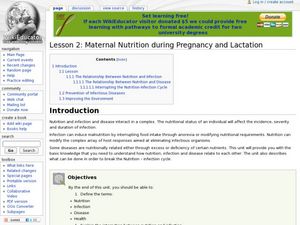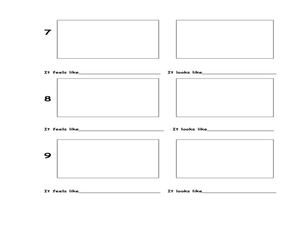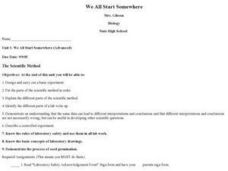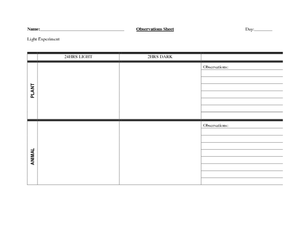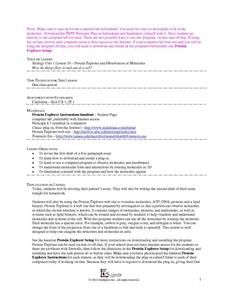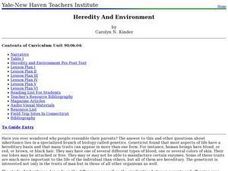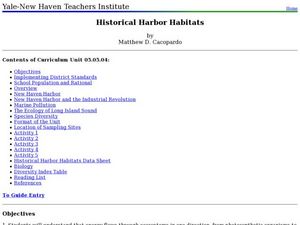Curated OER
CONSTRUCTION OF A HEMOGLOBIN GENE
High schoolers use research to see how eight pairs of triplets are equivalent to part of a gene and control a part of heredity. They also understand how red blood corpuscles manufacture normal hemoglobin.
Curated OER
How Smoking Affects Our Repiratory System
Seventh graders examine the dangers of smoking. In this life science lesson, 7th graders survey their schoolmates about the factors that would influence them to smoke. They present their findings in class by creating a presentation.
Curated OER
Maternal Nutrition during Pregnancy and Lactation
Students explain the relationship among nutrition, infection and diseases. In this health science lesson, students suggest ways to break the nutrition-infection cycle. They brainstorm solutions to prevent infectious diseases in the...
Curated OER
Puberty
Eighth graders describe the changes their body undergoes during puberty. In this health science lesson plan, 8th graders explain how the hypothalamus and pituitary gland play a major role in the process. They identify the different parts...
Curated OER
Exploring Marine Objects
Learners identify the sources of water on Earth. In this life science lesson, students list the different plants and animals that live in the ocean. They explore marine objects in the lab and draw them.
Curated OER
Plants
Students identify and label parts of a plant. They will construct a plant from art material and describe the purpose of each part for the plants survival. Students author a book with pictures and words or a story about a plant.
Curated OER
We All Start Somewhere
Students demonstrate an understanding that the same data can lead to different interpretations and conclusions and that different interpretations and conclusions are not necessarily wrong, but can be useful in developing other scientific...
Curated OER
Wagons Test
Students examine the characteristics of different biomes. In this ecology lesson, students design biomes where given animals can live. They discuss the design within the group and share it with the class.
Curated OER
Organisms – Their Needs
Students compare and contrast different organisms characteristics. In this life science lesson, students design an experiment about plants and animals needs. They collect data and write their conclusion about the experiment.
Curated OER
Observing and Drawing Structures of Guppies and Goldfish
Students observe fish and focus on their structures. In this life science lesson, students work in a group and observe guppies and gold fish.
Curated OER
Science: Trouble in the Troposphere
Students research a NASA Website and record information about an assigned city's tropospheric ozone residual monthly climate. In groups, they graph the information for the past year. They form new groups and compare their city's...
Curated OER
The Opposable Thumb
Students explore the physical importance of the opposable thumb among primates. They discover which of their simplest daily activities are possible only because of their opposable thumbs.
Curated OER
How do things flow in and out of a cell?
Students use a word processing program successfully. They are able to complete a final draft of a Lab Report and turn in all drafts for a formal letter grade. Students finish type their Lab Reports, they are reminded to use the spell...
Curated OER
How do things flow in and out of a cell?
High schoolers revise thier partner's essay. They also write the second draft of their essay for homework. Students use the Protein Explorer web site to visualize molecules, ATP, DNA, proteins and lipid bilayer. They are able to see...
Curated OER
A Clone of Your Own: The Legal Issues and the Future of Genetic Engineering on Humans
Twelfth graders define cloning in their own words and examine the different types of cloning. After reading an article, they summarize it in their own words and use the internet to research the history of cloning. In groups, they...
Curated OER
Cardiac Arrest! Using Forensics to Investigate Cardiovascular Anatomy and Function
Learners identify the different parts and functions of the cardiovascular system. In this forensics lesson, students collect and analyze evidence on a fictional crime. They describe different causes of cardiac arrest.
Curated OER
Culture, Crisis and Population Explosion: A Deweyan Approach in the Classroom
Young scholars read various arguments posed by John Dewey when it comes to population growth. In groups, they use magazine articles and the internet to find issues related to populations and complete experiments to identify the...
Curated OER
Investigating Factors That Affect Rate of Enzyme Action
Students explore the properties of enzymes. In this chemical reaction lesson, students explore enzymes through a Web-quest and investigative study. Students will collect and summarize data and create a class presentation. This lesson is...
Curated OER
Cell-to-Cell
Ninth graders use online tutorials, class discussion, presentations and scientific articles to explore types of cells along with cell structure, function and behavior. They explore ethical questions related to cells and disease.
Curated OER
The Cell
Students study the basic processes by which cells divide and transfer their genetic information. They recognize and distinguish possible inherited traits and through the discovery method of the facts and principles of inheritance. this...
Curated OER
Quick Concept Demonstrations
Students research the nervous system. Demonstrations on how to pick up keyed information in text is shown daily and weekly. Reviewed for content is Nerve Impulse, Polarization and Depolarization and perception. A spreadsheet will graph...
Curated OER
Basic Introduction to Foundation of Life: Genes, Genetics and Genetic Diseases
Students are introduced to genetics along with genetic diseases and heredity. In groups, they complete a Punnett Square to determine the dominant and recessive genes. After viewing diagrams, they identify the characteristics of DNA and...
Curated OER
Heredity And Environment
Students complete a pre-test on the relationship between heredity and the environment. As a class, they write down descriptions of themselves and identify which traits can be changed and not changed. In groups, they determine which genes...
Curated OER
Historical Harbor Habitats
Tenth graders create food web displays in the classroom. In this ecology lesson, 10th graders identify the different pollutants in the environment and their effect on organisms. They collect samples of sediments from the harbor and...




